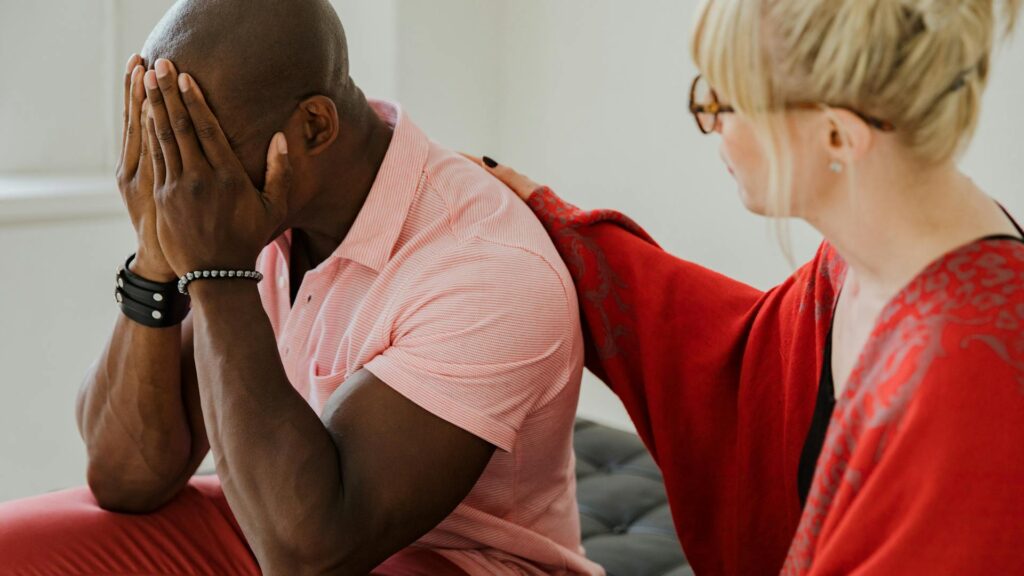This article discusses mental health crises, including mentions of self-harm and suicide.
If you or someone you know is experiencing a mental health crisis, help is available.
Call 911, go to the nearest emergency room, or call or text 988 to reach a trained crisis counselor at the Suicide & Crisis Lifeline.
A mental health crisis can be an extremely challenging thing for to deal with. According to the National Alliance on Mental Illness (NAMI), the warning signs of a mental health crisis include:
- Trouble with everyday tasks involving personal hygeine or getting dressed
- Sudden, extreme mood swings
- Increased agitation
- Isolation or paranoia
- Abusive behavior — either to themself or others — which includes self-harm and substance abuse.
- Symptoms of psychosis like inability to recognized loved ones, hearing voices, or seeing things that aren’t there
In addition, people showing the warning signs of suicide should be considered to be experiencing a mental health crisis.
A person in crisis might feel afraid, hopeless, and alone. In these moments, receiving outside help is crucial – and that’s where crisis intervention comes in.
Crisis intervention refers to strategies designed to provide immediate assistance to individuals experiencing a mental health emergency. Mental health crises are more common than you think, and knowing what to do in a crisis could help you save a life.
Whether you’re experiencing a crisis yourself, or you’re a mental health professional or someone supporting a loved one in distress, understanding and applying the Safer-R model can be a lifesaving tool in navigating these crisis situations.
Read on to learn about the Safer-R model of crisis intervention and its applications.
Introduction to the Safer-R Model of crisis intervention
Safer-R stands for Stabilize, Acknowledge, Facilitate, Encourage, Recovery, and Referral — all explored in more detail below. This model of crisis intervention was developed in 1996 by psychologist Dr. George Everly, who specializes in crisis intervention and psychological first aid. It was created as a part of the Critical Incident Stress Management (CISM) framework. This model provides a structured framework for mental health professionals and crisis responders to address a crisis safely.
When someone follows the steps of The Safer-R model, they can assess the severity of the crisis, intervene effectively, and ensure the individual’s safety. The model stresses the importance of immediate crisis intervention to prevent worsening of the individual’s mental state and current crisis.
Mental health professionals, like me, may use the Safer-R Model as a structured approach to assess the situation, provide immediate support, and connect individuals in crisis with further assistance and treatment options.
- Dr. Melissa Galica, Ph.D
It’s considered a biopsychosocial model since it addresses:
- Biological needs
- Psychological needs
- Social needs
To sum it up: “The Safer-R Model aims to prioritize safety, assessment, first aid, and referral to appropriate resources,” says Dr. Melissa Galica, Ph.D., a licensed professional counselor with Grow Therapy. “Mental health professionals, like me, may use the Safer-R Model as a structured approach to assess the situation, provide immediate support, and connect individuals in crisis with further assistance and treatment options.”
Ultimately, the process ensures that you get the individual in crisis safe and then take steps to ensure they stay safe.
Breakdown of the Safer-R Model
Looking to gain a better understanding of this model for crisis intervention? Here’s a breakdown for you. (Remember: You should always call 911 or 988 right away during crises where someone is at imminent risk of harming themselves or another person.)
S – Stabilize the situation
First things first, you need to assess the situation when you first become involved or aware of what’s happening. This is the time to establish the physical safety for the individual in crisis and other people involved. Think about their basic needs regarding physical health. Are they hurt? Do they need food or water? Addressing these needs will help them better communicate with you and work through the next steps.
During this step, try to use calm, empathetic language to let the other person know that you’re there for them and they aren’t alone. Make sure that your tone of voice and body language are not threatening; for example, keep your tone of voice and body language relaxed and try not to make sudden movements. The last thing you want to do is stress the individual out even more.
If the person in crisis is open to it, you can also encourage them to practice slow, deep belly breathing with you. This can help you both de-escalate heightened anxiety and emotions. For example, you could say: “I noticed that my heart is racing, and I feel very activated. Do you mind if we take a few moments to do some deep breathing together, which may help both of our nervous systems calm down?”
A – Acknowledge the crisis
Once the person in crisis is more stabilized, it’s time to figure out what happened. You want to learn about the event and their reaction to the event. Encourage them to express their feelings and experiences while practicing active listening. Try to remain non-judgemental while you validate their difficult emotions. Show empathy and understanding for the situation; try saying something along the lines of “Listening to the tone of your voice, it sounds like you might be feeling (insert emotion), is that how you’re feeling?”
F – Facilitate understanding
The individual in crisis might be feeling ashamed, scared, or alone. To counteract this, it’s important to help normalize their reaction. As they tell you about what led to the crisis, let them know that their thoughts and feelings are a common, understandable response to a major stressor or trauma. You can express your empathy by saying something like, “Wow, that’s really hard. I imagine most people in the same position would feel the same as you.”
Reassure them that they are not alone in this, and they can get through this and feel better. This reminder is crucial during a crisis, when it might feel like there’s no light at the end of the tunnel.
E – Encourage effective coping
This step starts to look forward and asks the question: How will this individual cope psychologically going forward? For example, you can ask the individual how they typically cope with stressful situations. Especially if they don’t have any healthy coping tools, you can introduce some new, positive strategies that can help them. Different coping skills work for different people; for some, things like breathing exercises, mindfulness, and self-compassion are effective. Other people find that playing non-violent video games for a little while, listening to music, or going for a run or walk help them cope.
If you can, return to the biological portion of the biopsychosocial model and stress the importance of physical self-care, hydration, and sleep following the crisis. Believe it or not, these physical aspects can make a big impact on mental health. Then, for the “social” part of biopsychosocial, stress the importance of peer support. Ask them about the social support they have from friends, family, and loved ones. This type of ongoing support after such an incident can make all the difference.
Use your problem-solving skills to collaborate and develop a practical, accessible, short-term action plan to address immediate concerns.
R – Recovery and referral
It’s important to create a follow-up plan to ensure ongoing support and monitoring. This step is crucial to set the individual up for success post-crisis. When considering what resources and support this person might need, make sure to address all aspects of the biopsychosocial model: physical, psychological, and social. The goal is to help the person identify what they can do to take care of themself and what resources they need to do it. Some ideas to offer are exercising when possible, getting quality sleep, seeking professional mental health help, and leaning on loved ones for social support after the incident.
Referral to professional help is also beneficial. You can suggest local or remote-friendly mental health clinicians, support groups, or other mental health services. If you don’t personally know of any, you can try to look some up just to give them a starting point.
Additionally, provide crisis hotline information they can call if they experience a mental health emergency again in the future.
- 988 Suicide & Crisis Lifeline (call or text 988)
- Crisis Text Line (text HOME to 741741)
- Substance Abuse and Mental Health Services Administration (SAMHSA) National Helpline (call 800-662-4357)
Application of the Safer-R Model in various settings
The Safer-R model is valid in a wide variety of settings. However, some professionals might practice it a bit differently.
“The Safer-R Model is recognized by many healthcare professionals in the US, but its adoption and implementation can vary across different healthcare settings and regions,” Galicia says. Here are some situations where the Safer-R model is used.
- In clinical practice: Mental health providers like therapists, psychologists, or psychiatrists can use it during crisis intervention sessions. This helps with both short-term and long-term healing. Additionally, there may be adaptation for use in teletherapy and virtual crisis intervention.
- In emergency services: First responders, such as paramedics and police, can apply the Safer-R model out in the field. These emergency responders may learn about the model in training programs for crisis response teams.
- In schools and universities: The model is also helpful for school counselors and campus mental health services. It can help these providers address crises, such as any traumatic events that happen on campus.
Ways the Safer-R Model is used in therapy
Therapy is a crucial tool for improving mental health and managing symptoms of mental health conditions or the aftermath of trauma. There are a few ways mental health clinicians utilize this model of crisis intervention.
Crisis intervention sessions
Sometimes, a client might come into a therapy session in acute distress. In this case a therapist might employ the Safer-R model right there in the session as part of crisis intervention therapy.
A licensed therapist can provide professional emotional support and effective coping mechanisms, as well as develop a short-term and long-term plan to ensure safety and well-being. Plus, they can give quality referrals to other mental health professionals if needed.
Preventive therapy
Therapy is a great place to learn various mental health tools. A therapist might teach you the steps of the Safer-R model, even if you don’t need immediate psychological crisis intervention. “I’ve used the Safer-R Model as a self-help tool, as it can empower individuals to recognize warning signs, prioritize their safety, and access appropriate support during a mental health crisis,” Galica says.
You can look at this as a self-help/self-care tool for managing a potential crisis. This may be especially helpful if you struggle with a serious form of a mental health condition. Whether you struggle with depression and suicidal ideation or substance abuse, it’s helpful to be prepared just in case an emergency does strike.
Long-term support
Using this model can help identify deeper issues during the crisis. These underlying causes can be safely and professionally explored in ongoing therapy. Therapy is a life-changing tool if you struggle with your mental health. You may need additional support after experiencing a traumatic mental health crisis or emergency.
Depending on your struggles, there are many different therapy modalities that can help you. A qualified therapist will assess your symptoms and history and then develop a treatment plan to help you feel better and achieve long-lasting recovery.
Are you looking for professional mental health support but not sure where to start? Grow Therapy can help you discover the right therapist who can improve your mental health after a mental health crisis.
On Grow Therapy’s site, you can use our filters to search for therapists in your state who accept your insurance plan. We offer online therapy and in-person care from qualified professionals from different backgrounds and specialties. Get started today to find the right therapist for you and start healing.

